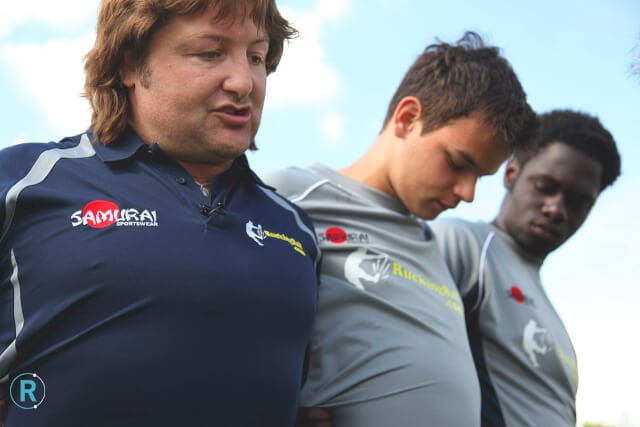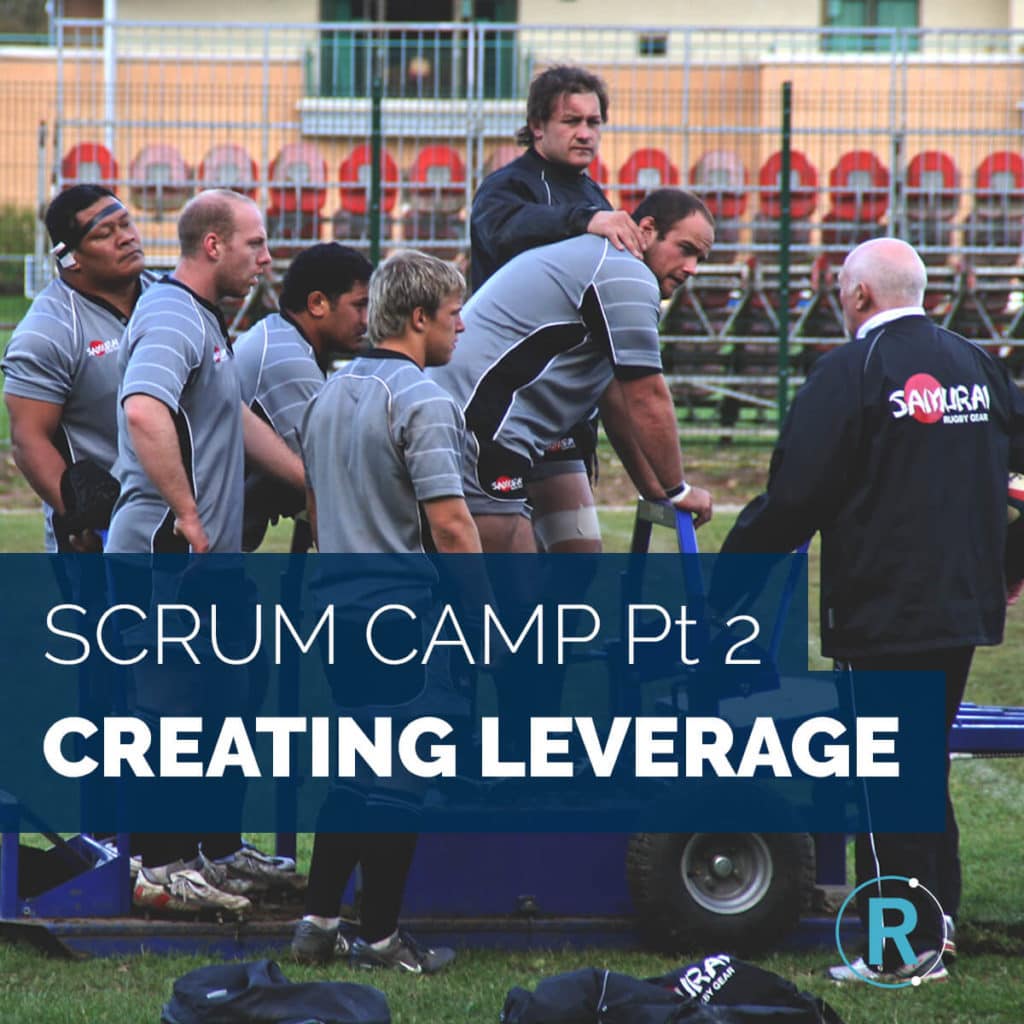Welcome back to Summer Scrum Camp!
Here we are looking at Part II of a 3-part series emphasizing the proper scrum fundamentals that will give your squad an edge this upcoming season. In Part I we spent the entire session hammering out proper body positioning in both the pre-engagement (1/4 to 1/2 squat) form and the post-engagement (90-90) form.
Correct posture is the basis for preloading the power of the scrum and unfortunately a weak area for many club level forwards across America. If you want to virtually guarantee scrum dominance, then training excellence of posture among your forward pack is critical.
Following the release of Part I of my series, I got some great feedback from my friend Carrick Pell who I played with briefly during my time with the Boston Irish Wolfhounds. Carrick has enjoyed a distinguished rugby career, playing hooker for many years.
Remember, the name of the game is leverage.
Clarke Cayton Tweet
Carrick’s observation (and I am in complete agreement) is that if players are unable or incapable of getting into proper position, all the technical training in the world will not result in a quality outcome. So please let me emphasize that if more training is needed in the area of correct posture, put in the work. First and foremost it’s a matter of safety, so please make it a priority and get it sorted.
With this foundational training piece covered in Part I, we can now continue to build the sustainable strength of the scrum by implementing proper binding techniques. This creates the structure that will enable the preloaded power to transfer through the front row and bring the pressure to the opposition. With proper training, this skill-set can be the difference between a quality scum and a dominating scrum.
The purpose of the binding itself is to maintain a balanced force within the formation. Without a secure bind among all of the players involved, an imbalance is created resulting in the loss of critical leverage. Mike Cron, famous scrum coach for the New Zealand All Blacks says that for him, maintaining balance is the most important aspect of a good scrum and that without a quality bind to hold the leverage together, the whole scum turns to custard.(1)
We are going for rock solid. Here’s how you get it done. Welcome to Scrum Camp, Day 2.
Warm Up Phase
Utilize your typical pre-match routine of stretching, calisthenics, etc., but consider adding some additional scrum-mobility specific exercises to limber up the body as well. I would even suggest integrating some basic yoga poses to loosen up the ligaments and tendons which will enhance the flexibility necessary to achieve proper scrum form. Achieving optimum ankle, knee, hip, pelvis, shoulder, and neck mobility are all vital preparation for a safe and powerful scrum.
A perfect routine to add to your warm-up regimen would be to incorporate a Sun-Salutation set found here: Yoga – a practical guide for rugby players.
Review Phase
Just like Day 1, get your squad straight into scrum position. Pack out your starting side of 8 and an oppositional side of no less than 5. Administer the call of Crouch – Bind – Set and instruct the players to hold (without push) as you walk around the scrum and observe the 90-90 body position of each player. Advising players to adjust their posture as necessary. When you are satisfied everyone is proper form, call for the scrum to release.
The squad should respond quickly so go ahead and rotate your players through until everyone has completed a minimum of 2 scrum downs.
If there are a few players still struggling to get into proper 90-90 position, provide another demonstration with two veteran players who can showcase exceptional form. Draw the players’ attention to the fundamental elements of both the pre-engagement and post-engagement positions as the two veteran players provide the visual example, interlocking in a 1-on-1 bind. Ensure understanding by then allowing your players to demonstrate their improved technique individually before moving on.
Assessment Phase
The emphasis on Day 1 was obviously proper body form and posturing. With that in place, Day 2 will focus on technical scrum alignment, which is established and maintained through proper binding. If power is created through body position, it is only sustained through its strength of bind. All you will do here during the assessment phase is observe the forwards and their process of “packing in”. Obviously, each individual position has a unique bind, so we’ll break the process into two parts to make it easier to assess.
Front Row Bind
Without an opposition, ask your front row to get in rugby ready position and bind together. It is essential that every player have their feet, knees, hips, and shoulders in alignment with each other (with the exception of the hooker who will have their feet slightly staggered). Any inconsistency in this frame structure will create two issues: 1.) Misdirection of leg power resulting in one side of the front row advancing ahead of the other, 2.) A loss of structural support from the second row. Either way, the scrum becomes inert.(2)
In order for the transfer of power load to be effective, there must be equal force distribution spread across the shoulders of the front row, originating from the force load created by the second row and flankers, through the hips and up the backs of the front row. If the joint alignment of the front row is off, this channel of energy collapses.
Provide a walk around assessment of the feet, knee, hip and shoulder alignment of all of your front-rowers, while in a pre-engagement bound position before moving on.

Second Row Bind
Once you have your front row set, call for your seconds (just locks for now). For this set, you will need at least a 5 man opposition to provide just enough bracing to hold the “Set”. As you administer the call for Crouch – Bind – Set, observe the position of the locks. Pay attention to two key elements, Are the locks able to fully extend their heads through the hips of the front row? And, Are the shoulders of the locks fully pressed against the back of the tops of the legs (just below the buttocks) of the hooker and props?
Just like Day 1, don’t jump in to correct any issues at this point, ask the players after each scrum, what they are feeling in their bodies. Allow them to communicate with one another and implement their own adjustments with your supervision. Complete 5 scum downs before rotating in new players and/or recycling multi-position players. Complete at least 3 cycles of 5. At the conclusion of the Assessment Phase, bring the pack together and briefly share your observations.
Instruction Phase
Now that your players have had a feel for what’s working and what needs some attention, you want to provide some position-specific instructions about quality binds. Have your front 3 get in scrum ready position, making sure there is alignment of feet, knees, hips, and shoulders, and have them bind together.
The challenge for most front rowers is to create tight pits and loose hips. Meaning you want the upper bodies to be pulled tightly together, but still have space at the waist for the head of the lock to extend fully through. Once your front row is properly aligned and bound, have your seconds step in. It is up to your props which bind they would prefer the locks to take; either wrapping the leg or grabbing the waistband.
But what your locks must bear in mind is that this is only a stability bind, the power comes through at the point of their shoulders, not their binds. If their shoulders become separated from the upper leg, their bind can potentially pull the prop down.
For now just work with your tight 5, lining up for a scrum down against an oppositional 5. Call the scum cadence and walk around observing the tightness of the bind as they hold the scrum. When you are satisfied, call for the release. Rotate through all your tight 5 players.
Now that you have successfully built the interior core of the scrum, add the back row for a full experience. The primary area of instruction for your flankers lies in their body symmetry to the locks. There can be a tendency, especially if the flanker bind is too loose, for the flanker’s hips to drift out. This results in the driving force pushing the prop inward instead of directly forward; a scenario that ends up becoming especially critical for the flanker biding to the loose head prop during a defensive scrum (more on this later).
Complete 5 full, 5 second held (no push) scrum downs with perfect position and perfect binding.
Drill Phase
Day 1 drills were focused on correct posture and the ability self-correct when pressure is applied. But scrummaging is not an individual activity. Every player must be able self-correct as part of a bound system. For Day 2, you will adapt each drill to incorporate pairs.
Tip Drill
- 2 players bind at the waist or upper sides in a 90-90 position, with outside arms extended and hands on the ground.
- Players hold this position as another player moves around their group attempting to push them off their territory.
- Rotate players, complete 3 rounds.
Dozer Drill
- 2 sets of 2 players bind at the waist or upper sides and then bind against each other, interlocking shoulders, with outside hands grasping the opponent’s jersey on each side.
- Working together in this bound position and maintaining 90-90 posture, first set of players advance 5 meters, as the second set retreats, but applies enough tension to maintain the hold. After 5 meters, the second set responds and reverses the movement now advancing 5 meters back.
- Complete 5 cycles of 5 up and 5 back.
Dip Drill
- 2 sets of 2 players bind at the waist or upper sides and then bind against each other, interlocking shoulders, with outside hands grasping the opponent’s jersey on each side.
- Working together in this bound position and maintaining 90-90 posture, first and second set slowly descend together maintaining their hold, until all four players’ knees are touching the ground. Then together they lift and return to 90-90 posture.
- Complete 5 dips.
- Rest, complete 3 rounds.

Teaching Phase
By now your squad should be squared away on the feel of proper technique for binding, this is a good time to begin sharing a bit of scrum strategy. By and large at the amateur club level, the approach to scrummaging is very elementary. Mainly, just push; and if you can’t advance your position at least hold your ground. That’s it.
This is great news for a squad who wants to commit to learning some advanced scrummaging techniques. If mastered, you will surely dominate your league. I assure you!
Bring the pack together and have your front 3 stand and face an oppositional front row so you can talk your forwards through some strategic moves.
Tight Head Prop
- On a defensive scrum, at the point of the initial hit, try to drive the Loosehead prop down to restrict the view of the hooker visualizing the ball.
- Establish your bind to the LH as early as possible and pull down and in (without collapsing).
- By gaining physical leverage (creating an imbalance of the LH), you initiate the drive. The scrum will not advance without this action!
Hooker
- At bind, place head as close to LH’s head as possible, minimizing the space the oppositional TH has to maneuver.
- Counteract any rotation by digging in and pulling your binds in the corrective direction. (The pivot point of every scrum is on the TH shoulder of the hooker, and must be resisted.)
Loose Head Prop
- On an offensive scrum, don’t allow yourself to be driven downward by the oppositions Tighthead. Becoming twisted is disastrous, so ensure your hooker is bound tight and pulling up, not pushing down.
- Each scrum change up your bind to the TH from short, mid, to long reach. This will keep him or her guessing and delay or diminish the quality of their counter-bind.
- Keep your left elbow high to keep the TH from getting leverage and pulling your left shoulder down.
- At impact, drive your right shoulder down on TH’s head causing their shoulders to dip below their waist, resulting in a loss of power.
- Use your head to drive the head of the TH in, diverting the force towards more of the pack.
Remember, the name of the game is leverage. If you find that you are outmatched, change up the timing of your engagement. On defense, try to hold your scrum ready stance a shade longer and allow the opposition to fall into you before making contact, this will cause them to overextend and become unbalanced. After one or two in a row, as they adjust and scale back their initial hit power, now counteract and hit them hard and early. Whatever you do, keep the opposition on their toes.(3)
Obviously we are playing into some grey areas here with the official, but if you can master this with skill, you can generate some key penalties that will give you an edge.
Implementation Phase
Begin with just your front row lining up against an oppositional front row. Go ahead and have them get into a bound 90-90 position. Call “Set” and have each Tight Head and Loose Head attempt the tactics above. Complete a set of 3, allowing for feedback from the 6 involved after each scrum. What worked? What didn’t?
If you need to supply a bit of additional external force, do so by pushing down on the outside shoulder of the offensive LH and/or provide an additional push behind the defensive TH.
Now transition to the full cadence, still with just your front rowers. Incorporate the binding and counter binding techniques for 3 sets. Continuing to invite feedback. Once you are satisfied with the physical demonstration of your Front 3, bring the rest of the pack in.
Here you will require a full 8 man opposition side. Administer the call of Crouch – Bind – Set and instruct the players to hold. Walk around the scrum, and verbally call out the tactic you want from either the offensive or defensive side. Get your hands on them too, so they feel the pressure of what it is you want them to do. The goal here for the primary team (offensive) to resist any movement other than directly pushing forward and equalized pressure across the front. Complete 3 scrum downs in this fashion.
Now that the tactics have been implemented per your direction, let the oppositional pack (playing defense) loose. Complete a minimum of 5 full on scrums, utilizing whatever tactics they want. Make your primary pack resist any and all attempts to disrupt their balance, force your pack to achieve control of the scrum before calling “release”. After each scrum, provide an opportunity for the players to share what’s working, what’s not working and what they need more from each other.
Reverse the ball possession and have your primary pack assume a defensive scrum set. Begin with 3 rounds where you walk around instructing your pack what pressure you want applied and where. The oppositional pack will do everything to resist.
Finally, let your primary pack have a go on their own, successfully dominating 5 scrums by either overtaking the position or forcing the opposition to collapse or front row disengage. Make your pack work until they have gained the advantage, before calling to release.
When you are satisfied, call an end to the session.
Competition Phase
Round 2 of SCRUMO Tournament!
- Only the winners from Day I will compete.
- Create a 12′ diameter circular field of play, ideally w rope, but flat agility cones will suffice.
- All players surround the circle, with 2 players in the middle.
- 2 players bind in 90-90 position and on the command “Set” attempt to drive each other in any direction outside of the circle. The first player to step out loses.
- If the players collapse or unbind the game is reset.
- All winners will advance to the final round on Day 3.
CONGRATULATIONS, you’ve just completed Day 2 of Scrum Camp.


